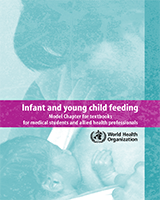From: SESSION 4, Management and support of infant feeding in maternity facilities

Infant and Young Child Feeding: Model Chapter for Textbooks for Medical Students and Allied Health Professionals.
Geneva: World Health Organization; 2009.
Copyright © 2009, World Health Organization.
All rights reserved. Publications of the World Health Organization can be obtained from WHO Press, World Health Organization, 20 Avenue Appia, 1211 Geneva 27, Switzerland (tel.: +41 22 791 3264; fax: +41 22 791 4857; e-mail: tni.ohw@sredrokoob). Requests for permission to reproduce or translate WHO publications – whether for sale or for noncommercial distribution – should be addressed to WHO Press, at the above address (fax: +41 22 791 4806; e-mail: tni.ohw@snoissimrep).
NCBI Bookshelf. A service of the National Library of Medicine, National Institutes of Health.